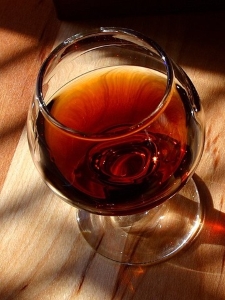 I saw a curious article in Forbes titled, 6 Things You (Probably) Didn’t Know About Cognac. Okay, okay, okay! I admit everything! I couldn’t stop myself from clicking on it! But here’s the thing: I didn’t click on it for my usual reason: that I think I’m so knowledgeable. The truth is that I don’t know much about cognac other than that it is the only kind of widely available brandy that is at all drinkable. And that it comes from Cognac, France. And, of course, that it is regulated by the government like the rest of the French alcohol industry.
I saw a curious article in Forbes titled, 6 Things You (Probably) Didn’t Know About Cognac. Okay, okay, okay! I admit everything! I couldn’t stop myself from clicking on it! But here’s the thing: I didn’t click on it for my usual reason: that I think I’m so knowledgeable. The truth is that I don’t know much about cognac other than that it is the only kind of widely available brandy that is at all drinkable. And that it comes from Cognac, France. And, of course, that it is regulated by the government like the rest of the French alcohol industry.
No, I was struck by the parenthetical “probably.” The article is, after all, in Forbes. And I suspect that the sort of person who reads Forbes thinks of themselves as pretty sophisticated. So throwing the “probably” in the title is a sop to their more insecure readers. The truth is, I was expecting to learn some things from the article. And I did! For example, I found out that cognac is rated from worst to best as: VS, VSOP, XO, and Extra.
Cognac Is All About Quality
This explains something that has been bothering me. I recently bought some cognac and I found that I didn’t like it as much as I remembered. So I just checked the label, and it is VS. I’m used to VSOP. So there you go!
But I was shocked by this line in the article, “It’s basically brandy.” Well, I can’t say that I knew that, because it is wrong. Cagnac is brandy. The statement in the article is like saying, “The Porsche 918 Spyder is basically a car.” I would assume that anyone who had ever tasted cognac would know that it is brandy. I’m not very aware of the outside world. Yet even with my tenuous grip on reality I am able to discern that it is brandy based upon my amazing ability to taste food and drink.
Forbes Readers Are Ignorant Snobs
Then it hit me: of course readers of Forbes would be surprised to learn that cognac is brandy. So surprised, in fact, that the article has to hedge on this fact. “It’s basically brandy.” If you look at a bottle of Hennessy, you will not find the word “brandy” anywhere. In the past, I’ve drunk cognac, not because I have a special fondness for it but simply because it was the best brandy that was readily available.
But for the Forbes set, it is probably a big deal that cognac is this thing that is expensive and thus good. For them, it is categorically different from brandy. So I image the editors concerned about this. “If we just say it is brandy, we’ll get angry letters!” But the most interesting thing about this is that for the Forbes reader, the fact that cognac is brandy probably was one thing they didn’t know about cognac. And it’s very sad. Or hilarious. It depends upon your perspective.






I’m not going to cheat and go to the link. Isn’t cognac a twice (at least) distilled wine made from champagne grapes? The small, sweet grapes that are used to make champagne, but not necessarily grown in the Champagne region, that is.
Most cognac is made from Champagne grapes, but not all; it’s not a requirement for the designation. What is required, however, is that it must have been made in the area just surrounding the town of Cognac to be legally permitted to bear the name of cognac. It seriously chaps the French authorities’ hide that коняк is the only word in Russian, and կոնյակ in Armenian, for “brandy” – meaning that if you order “cognac” in Russia, or anywhere that Russian is spoken, you are as likely to be served Ararat as Hennessy.
Frank – have you ever tried Armagnac, or Bas-Armagnac? They’re from regions not too far away from Cognac; the distillation and aging methods are the same but the result is subtly different – might be better or worse depending on your taste. I first became aware of Bas-Armagnac through stumbling on a ridiculously good deal at Trader Joe’s many years ago; at the time, the XO they were carrying* was a bit less than my then-standby Courvoisier VSOP, and I found I liked it better (ceteris paribus, older is usually better). I’ve never found such a great deal again, but it broadened my scope of possibilities for really good eau de vie that doesn’t break the bank.
* I’d never heard of the producer before then, and I’ve sadly long since forgotten the name. Should’ve saved the label.
Mark.
I think you’ll find that Armagnac is distilled once whereas Cognac is distilled twice. ;-)
Interesting. I think this is one of the reasons I’ve never learned that much about cognac: it’s a very dense subject. I just know what I like. (And that cognac is brandy!) But all this talk has had me thinking about port. I haven’t had any of that in years.
There are two sub regions in the Cognac called Petite Champagne and Grande Champagne. If your brandy is called Champagne Cognac, it is because the grapes are sourced from one or both of those sub regions inside of the Cognac Region. The Region in Northeastern France that produces the iconic sparkling white wine, has nothing to do with Champagne Cognac.
I totally agree with you that Armagnac is a great deal. A good Hors d’Age Armagnac from the 80’s is usually between $100 and $200 while its Cognac counterpart would cost three to five times that amount.
So all cognac is essentially “Champagne” cognac and there is a bubbly cognac?
Even though the prices by the shot are quite good, paying a couple hundred bucks for a bottle is kind of hard to imagine myself doing.
I haven’t, that I know of. I will be on the lookout. But I do know from experience that I’ve had excellent brandies that weren’t “cognac.” The word has come to be a shorthand, but as I think I mentioned in this article, the last cognac I bought was not very good.
Of course, now, I’m focused on beer, which is actually a whole lot more expensive than any cognac I’ve ever bought (comparing shots to pints).
Something like that. The article dealt with that. And there is something like brandy champagne that I’ve come upon in the past. But as I said, I don’t know much about this stuff. My focus was more on Forbes and how their readers are as pretentious as I am!
I won’t claim sophistication, but I did discover Armagnac while holidaying in Metz. Let it sit on your tongue and breathe slowly in. Bliss.
I think you have a poem sitting in there, Dane. Well put. Sophistication is relative. I find it a great blessing that my appreciation of wine stops at about the $10-$15 range. Above that, I’m just wasting my money because I can’t taste what makes it better. With brandy, I have never had the kind of money to learn that I’ve (probably) already reached that point.
Good to great champagnes are made usually from grapes that are picked earlier than table wine grapes because the wineries want the higher acidity. So they are not really sweet. I worked in West Africa for a few years and was able to acquire Armagnac. I liked it very much. Much better than the South African brandies we could find. My personal favorite is Remy Martin from the Cognac region. There are a few good brandies now from California, you just have to taste and see what you like.
I think that’s the issue. But it’s expensive to do much tasting — at least with brandy. That’s why it’s good to have suggestions. I think I had a California brandy a few years ago and it was very good. I’m not sure. I’m sure it was very good. I’m not sure it was from California.
I never knew what cognac was. All I knew was I had it at a wedding once, it looked like whiskey, it sure as hell didn’t taste like whiskey, and whiskey is my favorite beverage, so I was disappointed. (Probably for the best. I can’t keep whiskey in the house. I like it too much. So I might not have been the best guest if there was free whiskey.)
So I looked up what cognac was after reading this, and, OK — it’s first distilled, then aged in oak barrels, just like whiskey. Hence the color. And Wiki had some fun stuff about how the aging process works that I’d never really thought about before. So then I looked at their whiskey page.
Well it turns out the exact way aging “works” isn’t precisely known. How to do it is known, and done expertly! You have to hand it to millenia of boozehounds. Through pure trial-and-error, they not only found how to turn basically any fermentable plant into a means of getting f****d up, they perfected methods of making it taste yummier.
Hey, brewers may not have known that yeast was millions of microorganisms, but they knew how to use it! (And some medieval brewers called yeast “God is good,” because, let’s face it, yeast is AMAZING.)
So now the Fun Thing For Today. To better learn how aging in oak works, chemically, a Scotch distiller sent whiskey and oak on the ISS. Yes, it’s Booze In Space!
http://www.theverge.com/2015/9/10/9300435/whiskey-space-taste-test-ardbeg-distillery-nanoracks
So the whiskey comes back after two years, and the master tasters taste it … and it’s Wrong. Something about near-zero-G screwed up the aging. Instead of getting yummy refinements to the flavor, the whiskey got bad flavors from the oak. They’ll analyze the heck out of it and try to figure out why.
Booze In Space! Gives a whole new meaning to the term “moonshine” …
See, I knew you were a writer! Now I can imagine you at a typewriter with a bottle of whiskey sitting there.
Interesting about booze in space. I’m thinking the issue is mixing. There’s probably a lot more mixing in space, whereas the process works via diffusion on Earth.